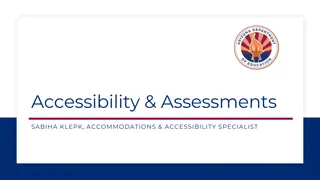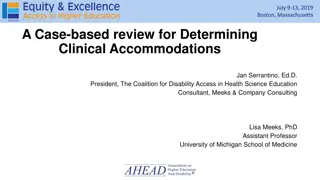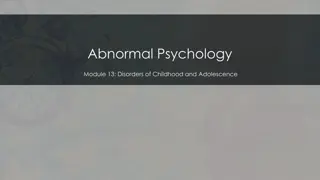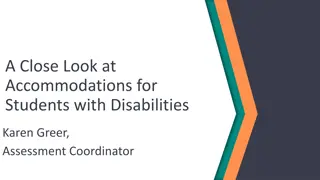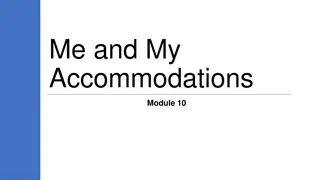Comprehensive Functional Neurodevelopmental Assessment for Accommodations
This assessment provides guidance on accommodations for individuals with neurodevelopmental challenges in different settings such as home, school, and community. It includes specific tasks, characteristics, strengths, and accommodations tailored to the individual's chronological age and developmental needs.
Download Presentation

Please find below an Image/Link to download the presentation.
The content on the website is provided AS IS for your information and personal use only. It may not be sold, licensed, or shared on other websites without obtaining consent from the author. Download presentation by click this link. If you encounter any issues during the download, it is possible that the publisher has removed the file from their server.
E N D
Presentation Transcript
FUNCTIONAL NEURODEVELOPMENTAL ASSESSMENT: FIT AND ACCOMMODATIONS The Grid Originally developed by Diane Malbin, MSW www.FASCETS.org
Setting: Chronological Age: Task or Expec- tation Brain Tasks Primary Develop- mental Age Secondary Charac- teristics Strengths Accom- modations Charac- teristics of disability
Setting: community Chronological Age: 10 Task or Expec- tation Brain Tasks Primary Develop- mental Age Secondary Charac- teristics Strengths Accom- modations Charac- teristics of disability Childwill engage in group play with other children. Understand/ interpret social cues, inhibit impulses, process & respond quickly Difficulty interpreting social cues, difficulty inhibiting impulses, slow processing speed Dysregula- tion, breaking rules of the game, aggression, withdrawing Wants friends, imaginative, athletic Opportuni- tiesto play with develop- mental peers, smaller groups, peer buddy 6
Setting: home Chronological Age: 10 Task or Expec- tation Brain Tasks Primary Develop- mental Age Secondary Charac- teristics Strengths Accom- modations Charac- teristics of disability Childwill wait patiently for a desired item or activity. Process auditory information, understand time, regulate emotions Difficulty with receptive language, poor concept of time, difficulty regulating emotions Screaming, tantrums, persevera- tion, aggression Able to utilizesome calming strategies, responds well to visual cues, easily distractible Offer known calming strategies, visual cues (timers, picture schedules), adjust length of wait, redirection 4
Setting: school Chronological Age: 10 Task or Expec- tation Brain Tasks Primary Develop- mental Age Secondary Charac- teristics Strengths Accom- modations Charac- teristics of disability Break down instructions, reduce distractions, work at appropriate academic level, sensory supports, DO NOT conse- quencebehavior that child cannot help Childwill remain on task during seatwork. Understand visual & auditory instructions, academic skills for assignment, inhibit impulses, ignore distractions Auditory processing difficulties, specific learning disabilities, difficulty inhibiting impulses, attention challenges Rocking in chair, frustration, yelling and/or arguing when corrected or given conse- quence Wants to please, works hard, may have specific academic strength 8








